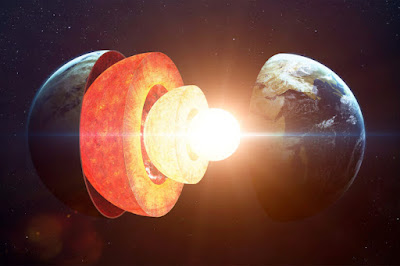原文網址:https://news.usc.edu/200185/earth-core-oscillates/
By Paul McQuiston
南加州大學的科學家發現的證據顯示地球的內核會來回震盪,這和之前公認的模型不同,其認為內核總是比地球表面旋轉得還快。
內核是顆跟冥王星差不多大的高溫緻密球體,證據顯示這幾十年來它會移動並且(或者)發生變化。圖片來源:AdobeStock
研究結果星期五發表在《科學進展》(Science
Advances),他們根據地震波數據的分析結果,得出內核在1969-74這六年間改變了旋轉的方向。科學家表示他們對於內核運動的模型也可以解釋一天長度的變化,過去幾十年來的觀測顯示一天的長度會持續地來回震盪。
「正如人們20年來主張的,從我們的發現可以看到地球表面和內核之間有著相對運動,」研究共同作者,南加州大學文理學院的教授John
Vidale表示。「然而,我們最近的觀測結果顯示內核旋轉的速度在1969-71變慢了一些,然後在1971-74變成往另一個方向旋轉。我們也注意到一天的長短變化正如預測的一樣。」
「這兩項觀測的一致性使得內核會來回震盪成為可能的解釋。」
分析核試爆來判定地核的旋轉速度與方向
內核是顆跟冥王星差不多大的高溫緻密球體。過去30年,我們對它的理解有了大幅增長,證據顯示這幾十年來內核會移動並且(或者)發生變化。也因為我們無法直接觀察內核,研究人員只能努力透過間接測量來解釋這些運動與變化的模式、速率以及成因。
1996發表的研究首次提出內核具有稱為超旋轉(super-rotation)的現象,也就是內核旋轉得比地球其他部分還快,大概是每年多出1度。之後Vidale的發現也鞏固了內核超旋轉現象的說法,雖然速率有所下修。
利用美國空軍在蒙大拿州架設的大孔徑地震儀陣列所得到的數據,研究人員Wei
Wang和Vidale分析了蘇聯1971-74在北極新地島群島的地下核試爆產生的震波。透過Vidale新開發的波束成形技術,他們發現內核的旋轉速率比之前預測的還慢,大概是每年多出0.1度。
這次的新發現來自Wang和Vidale運用相同的技術分析時間較早、阿留申群島尖端的阿姆奇特卡島地下進行的兩場核試爆,分別是1969年的Milrow試驗和1971年的Cannikin試驗。他們測量這兩場核彈爆炸產生的壓縮波之後,發現當時的內核是往反方向旋轉,每年至少比地球其他部分慢了十分之一度。
這項最新的研究是首次透過直接觀察地震波的訊號推導出為人熟知的六年震盪。
「雖然早就有模型呈現出內核會震盪的理論,但是學界對於該理論是否真的可行卻分成兩派,」Vidale表示。「我們本來預期在比較早的兩次核試爆中,會看到內核以同樣的方向和速率旋轉,但結果卻相反。發現內核會往另一個方向旋轉真的讓我們大為驚訝。」
未來研究方向:深入探討地球內核的成因
Vidale和Wang都強調未來的研究將依據能否找到足夠精確的觀測數據來和他們的結果互相比較。Wang表示他們透過前人研究中核試爆產生的震波數據,可以準確定出這些非常單純的震波事件發生的時間地點。然而,蒙大拿州的大孔徑地震儀陣列在1978停止運作以及美國地下核試爆時代的落幕,意謂研究人員必須仰賴相對而言精確度較差的一般地震數據,即使近年來儀器已經進步不少。
研究確實支持了內核會震盪的猜測。這項猜測的根據為之前觀測日長度以六年為期增減0.2秒的變化以及磁場變化,這兩者的振幅與相位都和他們的理論相符。Vidale表示他們的發現對於科學社群提出的諸多問題提供了一個可信的理論。
「內核並非靜止不動,它會在我們腳下運動,而且每六年似乎就會來回移動數千公里,」Vidale表示。「我們想要解開的一個問題是:內核的移動是逐漸進行?或是長期來看,大部分時間它跟其他地方相較來說是靜止的?我們正在試著瞭解內核是如何形成,以及隨著時間會有怎麼樣的運動,這是了解此作用中很重要的一步。」
The Earth moves
far under our feet: New study shows Earth’s inner core oscillates
USC scientists have found evidence that
the Earth’s inner core oscillates, contradicting previously accepted models
that suggested it consistently rotates at a faster rate than the planet’s
surface.
Their study, published Friday in Science Advances, shows that the inner core changed direction in
the six-year period from 1969-74, according to the analysis of seismic data.
The scientists say their model of inner core movement also explains the variation
in the length of day, which has been shown to oscillate persistently for the
past several decades.
“From our findings, we can see the Earth’s surface
shifts compared to its inner core, as people have asserted for 20 years,” said
John Vidale, co-author of the study and Dean’s Professor of Earth Sciences at
USC Dornsife College of Letters, Arts and Sciences. “However, our latest
observations show that the inner core spun slightly slower from 1969-71 and
then moved the other direction from 1971-74. We also note that the length of
day grew and shrank as would be predicted.
“The coincidence of those two observations makes
oscillation the likely interpretation.”
Analysis of
atomic tests pinpoints Earth core rotation rate and direction
Our understanding of the inner core has expanded
dramatically in the past 30 years. The inner core — a hot, dense ball of solid
iron the size of Pluto — has been shown to move and/or change over decades.
It’s also impossible to observe directly, meaning researchers struggle through
indirect measurements to explain the pattern, speed and cause of the movement
and changes.
Research published in 1996 was the first to propose
the inner core rotates faster than the rest of the planet — also known as
super-rotation — at roughly 1 degree per year. Subsequent findings from Vidale
reinforced the idea that the inner core super-rotates, albeit at a slower rate.
Utilizing data from the Large Aperture Seismic Array,
a U.S. Air Force facility in Montana, researcher Wei Wang and Vidale found the
inner core rotated slower than previously predicted, approximately 0.1 degrees
per year. The study analyzed waves generated from Soviet underground nuclear
bomb tests from 1971-74 in the Arctic archipelago Novaya Zemlya using a novel
beamforming technique developed by Vidale.
The new findings emerged when Wang and Vidale applied
the same methodology to a pair of earlier atomic tests beneath Amchitka Island
at the tip of the Alaskan archipelago — Milrow in 1969 and Cannikin in 1971.
Measuring the compressional waves resulting from the nuclear explosions, they
discovered the inner core had reversed direction, sub-rotating at least a tenth
of a degree per year.
This latest study marked the first time the
well-known six-year oscillation had been indicated through direct seismological
observation.
“The idea the inner core oscillates was a model that
was out there, but the community has been split on whether it was viable,”
Vidale says. “We went into this expecting to see the same rotation direction
and rate in the earlier pair of atomic tests, but instead we saw the opposite.
We were quite surprised to find that it was moving in the other direction.”
Future research
to dig deeper into why Earth’s inner core formed
Vidale and Wang both noted future research would
depend on finding sufficiently precise observations to compare against these
results. By using seismological data from atomic tests in previous studies,
they have been able to pinpoint the exact location and time of the very simple
seismic event, says Wang. However, the Montana Large Aperture Seismic Array
closed in 1978 and the era of U.S. underground atomic testing is over, meaning
that the researchers would need to rely on comparatively imprecise earthquake
data, even with recent advances in instrumentation.
The study does support the speculation that the inner
core oscillates based on variations in the length of day — plus or minus 0.2
seconds over six years — and geomagnetic fields, both of which match the theory
in both amplitude and phase. Vidale says the findings provide a compelling
theory for many questions posed by the research community.
“The inner core is not fixed — it’s moving under our
feet, and it seems to going back and forth a couple of kilometers every six
years,” Vidale said. “One of the questions we tried to answer is, does the
inner core progressively move or is it mostly locked compared to everything
else in the long term? We’re trying to understand how the inner core formed and
how it moves over time — this is an important step in better understanding this
process.”
原始論文:Wei Wang, John
E. Vidale. Seismological observation of Earth’s oscillating inner core. Science
Advances, 2022; 8 (23) DOI: 10.1126/sciadv.abm9916
引用自:University of Southern California. "The
Earth moves far under our feet.”

沒有留言:
張貼留言